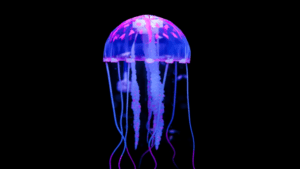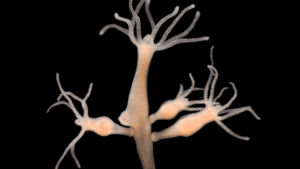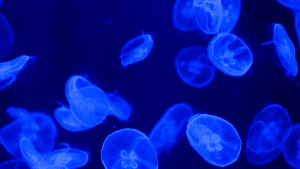
Cnidaria
Cnidarians or Cnidaria are the first true metazoans (having bodies comprised of cells that are differentiated into tissues), exclusively aquatic. About 99% of Cnidarians occur in the marine environment and the rest 1 % occur in fresh water. Corals, sea anemones, and jellyfish belong to this phylum. In this article, we will learn more about cnidarians.
Definition
(Gr knide = sting cell) Cnidaria or Coelenterata ( Gr., koilos = cavity+ enteron = intestine) are diploblastic metazoans having well-defined tissues with a gastrovascular cavity (coelentron) and possess specialized stinging cells.
Overview
All cnidarians have attained tissue-level organization with the division of labor in elementary conditions. They have no developed organs. If sponges are the first step to multicellularity, cnidarians are one step advanced in having certain features absolutely unique to this group.
- Tissue level body organization as compared to the cellular level of sponges.
- Presence of digestive, gastrovascular cavity, nerve cells, sensory cells
- Development of a simple muscular system and stinging organelle for defense and offense.
- Totipotent interstitial cells
Evolution
In the proterozoic era, the Precambrian period the cnidarians made their first appearance,- medusa being the original body form. Gradual evolution to various forms and groups took place through the Triassic, Jurassic, and Cretaceous periods till the present. Sea anemone fossils were from the Cambrian period.
Key features of Cnidaria
- Multicellular organisms with tissue level of organization.
- Organisms are diploblastic – with acellular mesoglea in between.
- Blind sac body plan, radial or biradial symmetry with a central gastrovascular cavity communicating with outside by mouth, anus absent.
- Tentacles are present around the mouth.
- Specialized stinging cells nematoblasts or cnidocytes are present.
- Cnidarians show polymorphism. Two main types of structures (zooids); the polyp(asexual generation) and medusa (sexual generation) are formed.
Major groups
1. Anthozoa

- Exclusively marine, colonial, or solitary polypoid forms only, medusoid stage absent.
- The mouth leads to a pharynx and not directly to the gastrovascular cavity, divided by mesenteries or septa.
- Mesoglea with cells and connective tissues, only polyp stage, medusa absent.
- Examples: sea pen, red coral.
2. Scyphozoa

- Exclusively marine, solitary with dominant medusa stage and polyp stage reduced.
- Individuals have umbrella-shaped bodies, mesoglea thick and gelatinous.
- Presence of marginal sense organs, gonads gastrodermis in origin..
- Examples: Jellyfish, Rhizostoma.
3. Hydrozoa

- Freshwater or marine, solitary or colonial, only polyps or both asexual polyps and sexual medusa are present.
- Mesoglea is devoid of cells, nematocysts only exist in the epidermis, single gas-filled floats with tentacles.
- Polyps without pharynx and septa, medusa with true velum(inward rudimentary fold of circular edge of umbrella).
- Examples: Hydra, Physalia.
4. Cuboza

- Cube-shaped body with tentacles hanging from each corner bearing nematocysts.
- Eyes are present in the body which can identify light and dark.
- Polyps are small or unknown, medusa has a flap (velum) to enable increased water flow and controlled swimming.
- Examples Box jelly
Anatomy and Morphology
- Exoskeleton chitinous (perisarc) or calcareous (corals).
- Organisms are solitary or colonial, fixed (benthic) or free (pelagic), acoelomate, diploblastic-ectoderm, and endoderm with gelatinous mesoglea in between.
- The outer epidermis consists of epitheliomuscular cells, cnidocytes, interstitial cells, nerve cells, and sensory cells.
- The inner gastrodermis consists of musculonutritive cells, gland cells (secretes digestive enzymes), interstitial cells, nerve cells, and sensory cells.
- Blind sac body plan i.e. digestive cavity with one opening to the outside, the anus is absent.
- Radially symmetrical body of even order: symmetry of four or six on which is superimposed a bilateral symmetry.
- The central gastrovascular cavity communicates with the exterior by mouth surrounded by tentacles.
- Respiration, circulation, and excretion take place by diffusion.
- The nervous system is primitive consisting of a diffused nerve net, The Central nervous system is absent.
- Colonial forms show polymorphism – Polyp and medusa forms.
Reproductive structure and life cycle

- Polyps represent the asexual generation
- They are cylindrical in shape, fixed to the substratum, and lack sense organs.
- Polyps give rise to new polyps through budding or fission as in Hydra.
- Some polyps bear gonozooids or Blastostyle that produce sexual medusa or gonophores- as in Obelia by a process called strobilation.
- Medusa represents the sexual generation.
- Free swimming, umbrella or bell-shaped, solitary with sense organs and gonads.
- The male gonads produce male gametes and the female gonads produce the female gonads, which release male and female gametes respectively.
- The fusion of male and female gametes results in fertilization and zygote formation.
- The zygote after repeated cell divisions gives rise to a free-swimming planula larva.
- This larva soon settles down on a substratum undergoes developmental changes and becomes a polyp.
- A new colony of cnidarians arises from these polyps through budding – a typical instance of metagenesis.
So the life cycle alternates between polyp (asexual) and medusa (sexual ) stages.
Feeding Digestion
- Gastrozooids or feeding polyps have a short tube-like body with conical projections – manubrium or hypostome.
- The mouth is borne at the terminal end of the manubrium surrounded by tentacles.
- Cnidarians are carnivorous, living animals or bodies of animals coming in contact with tentacles are held and paralyzed by nematocysts.
- The tentacles holding the prey are bent toward the mouth which receives it. The mucus is secreted by the gastrodermis of the manubrium.
- Digestion is both extra-cellular and intracellular.
- Extracellular digestion occurs in the gastrovascular cavity, secreting proteolytic enzymes
- Food is reduced to a mixture of liquid and food fragments.
- The food fragments are engulfed by phagocytosis into the food vacuole.
- Intracellular digestion takes place in the food vacuole.
- Proteins and fats are digested but starch is left undigested.
- The whole process of digestion is completed within a few days.
- Undigested parts are removed through the mouth and excess food is stored in the gastrodermis in the form of fat, and glycogen.
Ecological importance
- Cnidarians especially the coral reefs are very important to the marine ecosystem, and help in maintaining biodiversity.
- Coral reefs protect the shoreline from erosion.
Adaptation and Survival Strategy
- Cnidarians have successfully adapted themselves to freshwater, surface water, and deep ocean water.
- Fluid present in the coelenteron creates a hydrostatic skeleton.
- The development of tentacles and cnidocytes helps in gathering, and capturing prey as well as restricting potential predators that compete for food and space through evolved chemical defenses.
- The development of sense organs helps them in responding to environmental stimuli.
- Many cnidarians like sea anemones have symbiotic relationships with arthropods which help them locomote and other cnidarians have developed symbiotic relationships with photosynthesizing algae.
Interaction with humans
- They form a part of recreational activities and tourist attractions from all over the world.
- Some jellyfish are a source of food for humans.
- Red corals serve for jewelry purposes and beautification.
- The cnidarian sting is very painful and in some cases, it can be fatal too.
Q&A
1. What are five examples of cnidaria?
Hydra, Aurelia, Portuguese man of war, Jellyfish, Sea anemone.
2. What are the five characteristics of cnidaria?
Diploblastic, acoelomate, radially symmetrical with tentacles and cnidocytes, polymorphism (polyp and medusa), Gastrovascular cavity.
3. Do jellyfish belong to cnidaria?
Yes
4. Why is coelenterate called cnidaria?
Presence of stinging cells cnidocytes or cnidoblasts.
SUMMARY :
- Diploblastic, acoelomate , radially symmetrical with tentacles and cnidocytes for offense and defense.
- The body wall has two cellular layers outer epidermis and inner gastrodermis with acellular mesoglea in between, tissue-level organization.
- Presence of gastrovascular cavity.
- Cnidarians have been classified into Anthozoa,Scyphozoa,Hydrozoa and Cuboza.
- Colonial forms show polymorphism.
- Two types of zooids –polyps and medusa.
- Respiration, excretion, and circulation take place by diffusion.
- The presence of a diffuse nerve net helps to respond to stimuli.
- Tentacles and cnidocytes capture prey and both extracellular and intracellular digestion take place.
- Polyp is the immobile asexual stage in most forms, gives rise to free swimming medusa form which gives gametes to form a zygote.
- The zygote forms a planula larva which can develop into a polyp or medusa form.
- This alternation of generation is metagenesis.
- Cnidarians play a major role in ecosystem biodiversity. Coral reefs form spots of tourist attraction.
- Forms a source of food to other animals and humans.
- Cnidarians came into being from the Proterozoic era, and Precambrian period and include hydra, corals, jellyfish, and sea anemones.
References:
1. The invertebrates – Protozoa through ctenophora – Publisher Tata Mc Graw Hills.
2. Biology of Animals (Volume 1 and II)
